Make a donation to the museum
1993 WTC Bombing As Told Through Artifacts
1993 WTC Bombing As Told Through Artifacts
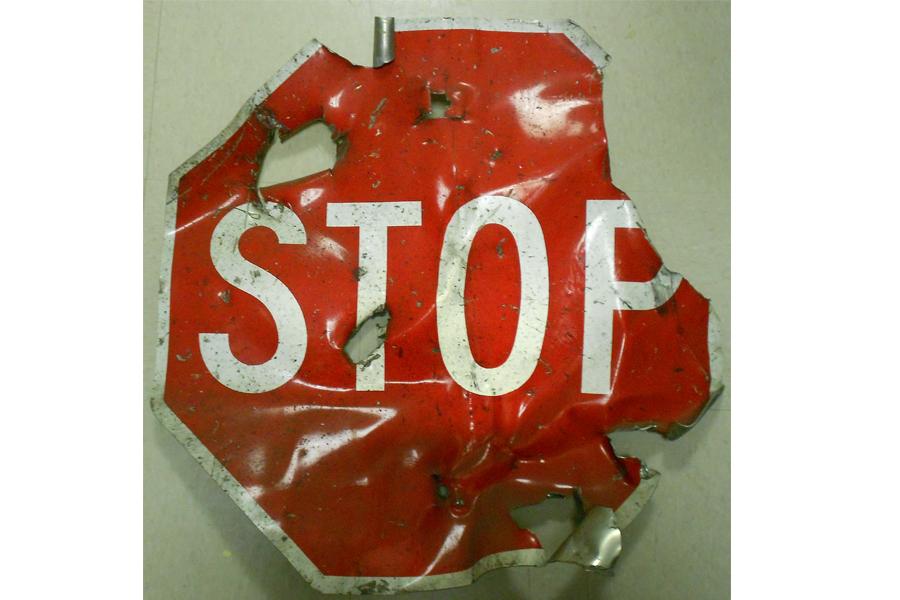
Twenty-seven years ago, terrorists detonated an explosive-filled van on the B2 level of the underground parking garage in the North Tower of the World Trade Center. While the terrorists’ mission to destroy the towers failed, six people were killed in the attack and hundreds were injured. We share this history from the events of the day to the investigation inside the 9/11 Memorial Museum through artifacts and firsthand accounts.
Stop Sign
On a snowy Friday in February 1993, amid reports of a transformer explosion at the World Trade Center, Cooper Union freshmen Gregory Miller and Justin Spivey decided to investigate the scene themselves. Emerging from the Cortlandt Street subway station, Miller and Spivey witnessed the mayhem of smoke-stained survivors charging away from the World Trade Center and the determination of first responders.
Surrounded by twisted metal on the ground near the ramp to the World Trade Center parking garage, they spotted two mangled STOP signs, punctured with holes and bent at the edges. Unaware of what happened at 12:18 p.m. that afternoon and that they were entering a crime scene, the college freshmen retrieved the signs, doubtful of their significance.
Miller and Spivey returned to school that afternoon, learning later of the updated reports of a truck-bomb explosion in the parking garage beneath the North Tower.
Both stop signs were donated and are part of the 9/11 Memorial & Museum’s collection.
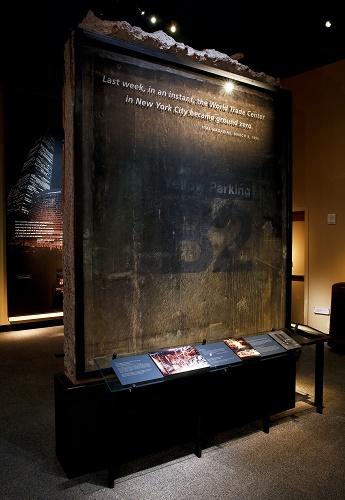
Wall Fragment
Around 12 p.m. a group of terrorists, led by Ramzi Yousef, drove their bomb-laden van into the vast public parking garage below the World Trade Center complex. After parking on the B-2 level and lighting the bomb’s fuse, cut long enough to provide them a head start of several minutes, the men escaped the garage in a car driven by an accomplice. At 12:18 p.m., an explosion ripped through the belowground parking garage, opening a crater 150-feet wide and several stories deep underneath the North Tower. Portions of the garage survived both the 1993 bombing and the attacks on Sept. 11, 2001. The soot stains seen on this fragment of the B-2 wall were the result of the fires that burned following 9/11.
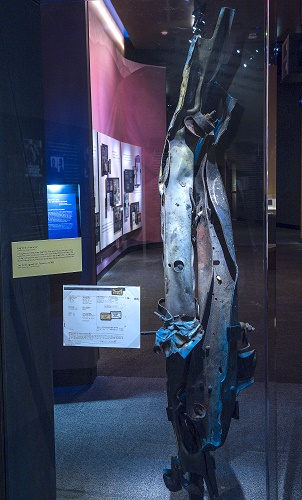
Van Fragment
When the story of the 1993 World Trade Center bombing arrests is told, much is made of how authorities were waiting for one of the plotters when he returned to the rental company in Jersey City looking to get his $400 deposit back for the truck that was packed with explosives.
But that dramatic sting operation would never have occurred and the perpetrators may never have been captured at all if it weren’t for a stroke of luck paired with some solid forensic knowledge that helped investigators quickly close in the perpetrator who rented the van before he had a chance to run.
The bomb blast that killed six people and injured more than 1,000 also caused massive destruction to the North Tower and the nearby Vista Hotel. Although the damage was not visible from street level, the explosion created a crater that was 150 feet wide and spanned six floors of the complex belowground.
That crater was filled with 4,000 tons of rubble—a crime scene that did not look like it would offer up clues so easily.
“But what happened was this piece… was thrown out of the crater a certain distance and it was discovered fairly quickly,” former federal prosecutor Michael J. Garcia recalled at 9/11 Museum public program in 2015.
The terrorists most likely thought the level of destruction was so severe that it would safely cover their tracks, Garcia said.
“I think what [the perpetrators] perceived was this van, which was packed with more than a 1,000 pounds of explosives, was obliterated, so there was no way anyone was going to trace that,” Garcia said.
And the truck fragment was not just any fragment: it had the vehicle identification number intact, giving investigators a direct connection to track down.
“By the time Mohammed Salameh, who is the one who was taped at the Ryder rental place, goes back really he really had no expectation that law enforcement was going to be on to the fact that a Ryder van from that rental place in New Jersey had been used in the bombing,” Garcia said. “But it really was a great break. And once that happened, the arrests came very quickly.
Salameh was cuffed on the spot. By March 1994, co-conspirators Ahmad Ajaj, Mahmud Abouhalima, and Nidal Ayyad had been arrested and convicted in the bombing. Two months later, they were each sentenced to 240 years in prison without the possibility of parole.
However, the mastermind of the 1993 attack, Ramzi Yousef, was able to flee the country hours after the attack. He was arrested two years later. During that time, he plotted a series of terror attack with his uncle, Khalid Sheikh Mohammed, the man who would later emerge as the mastermind of the 9/11 attack.
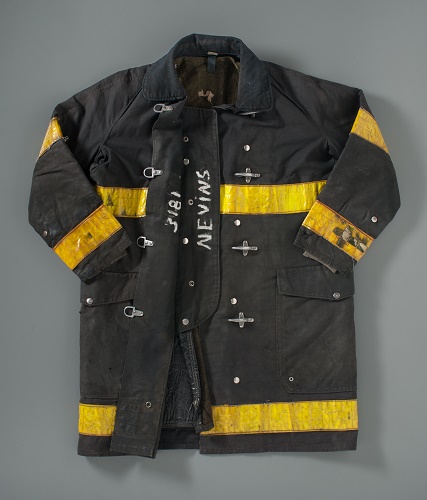
FDNY Bunker Coat
Minutes after the explosion, first responders began to arrive on the scene. A block south of the World Trade Center, firefighters of FDNY Engine Company 10 and Ladder Company 10 felt the rumble of the blast. Thinking a transformer exploded, they responded to the World Trade Center and confronted evidence of an explosion of far greater magnitude.
Several hundred rescue personnel from various agencies, including the FDNY, NYPD, Port Authority Police Department (PAPD), Office of Emergency Management (OEM), and New York City Emergency Medical Service (EMS), answered calls to mobilize. Drawing personnel from around the metropolitan area, the response became the largest emergency mobilization in the city’s history at that time. During the rescue operation, 88 firefighters, 35 police officers, and one EMS worker suffered injuries, almost all from smoke inhalation.
An FDNY-issued bunker coat worn by Gerard Terence Nevins when he responded to the 1993 World Trade Center bombing can be found in the 9/11 Memorial Museum’s permanent collection. According to the New York Times, Nevins “lived a life of sweet contradictions. His primary job was fighting fires. But when he was not pulling people from burning buildings, he was tending to his small farm in the backyard of his house in Campbell Hall, N.Y.” Nevins responded to the World Trade Center on September 11, 2001, with his unit, Rescue 1, and was killed along with 10 other members of Rescue 1.
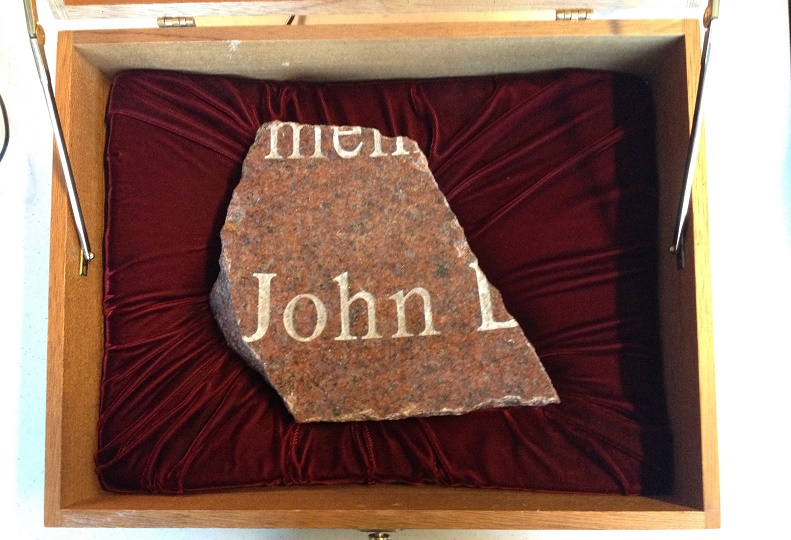
1993 Memorial Fragment
Designed by New York City artist Elyn Zimmerman, the memorial design mirrored a temporary memorial created by Port Authority staff in March 1993. The names of the victims—John DiGiovanni, Robert Kirkpatrick, Stephen Knapp, William Macko, Wilfredo Mercado, and Monica Rodriguez Smith (and her unborn child)—were inscribed in a 30-foot by 30-foot granite memorial which was placed on the World Trade Center’s Austin J. Tobin Plaza.
On September 11, 2001, the 1993 memorial fountain was destroyed. Only a single fragment from the 1993 memorial, bearing part of John DiGiovanni’s name, was recovered from the rubble.
On February 26, 2005, the remnant was placed in a temporary memorial near Ground Zero. For years, the fragment has been part of the ceremony commemorating the anniversary of the first attack on the World Trade Center.
A reliquary box was created by a friend of victim William Macko to house the fragment during the ceremony. The fragment has since been relocated to the 9/11 Memorial Museum where it can be seen on display with other artifacts from the 1933 bombing.
By 9/11 Memorial Staff
Previous Post
Remembering the Victims of the 1993 Bombing of the World Trade Center

Today we honor the six victims of the first attack on the World Trade Center on February 26, 1993.
Next Post
One Passenger’s Powerful Message to His Wife on 9/11
When Julie Sweeney Roth first saw Brian Sweeney, she told a friend “that’s the kind of guy [she] would marry.” Seven months later, she and Brian had their wedding on Cape Cod, a place Brian had always loved and where the couple would eventually live permanently.